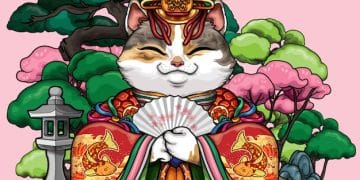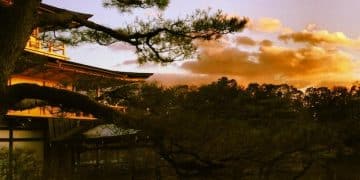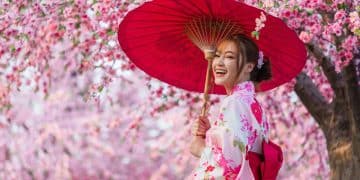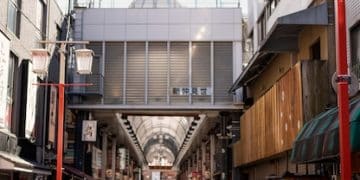Japan’s Art and Culture: A US Visitor’s Museum & Gallery Guide
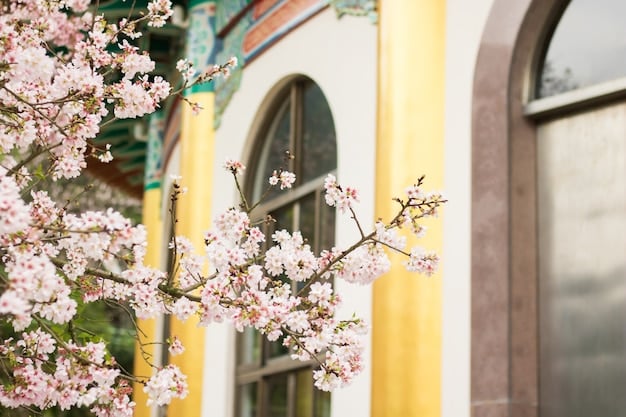
Japan’s Art and Culture Guide: Exploring Museums and Galleries for US Visitors offers a curated journey through Japan’s rich artistic heritage, providing essential insights for American travelers seeking immersive cultural experiences and artistic masterpieces.
Planning a trip to Japan and eager to dive into its vibrant art scene? Our Japan’s Art and Culture Guide: Exploring Museums and Galleries for US Visitors is your passport to discovering the best artistic treasures Japan has to offer, tailored for the American traveler. Get ready to explore traditional and contemporary art, from ancient masterpieces to cutting-edge exhibitions.
Unveiling Japan’s Rich Art and Culture Scene
Japan boasts a profound artistic legacy, intertwining traditional craftsmanship with contemporary innovation. From ancient pottery to modern anime, the country offers a diverse range of artistic expressions that captivate visitors from around the globe. This guide highlights the essential experiences for US visitors eager to explore this cultural richness.
Understanding the nuances of Japanese art involves appreciating the concepts of wabi-sabi (embracing imperfection) and a deep connection with nature. These themes permeate various art forms, providing a unique lens through which to view Japanese culture.
Traditional Art Forms to Explore
Delving into traditional arts offers a glimpse into Japan’s historical roots. Consider exploring the following:
- Calligraphy (Shodo): Appreciate the elegance and discipline of brushstrokes that convey both meaning and artistic expression.
- Pottery (Yakimono): Discover regional variations in clay, glaze, and firing techniques that reflect local aesthetics and traditions.
- Textiles ( textiles): Admire the intricate patterns and techniques used in kimono weaving, dyeing, and embroidery.
These art forms are often showcased in museums and galleries, offering an accessible introduction to Japan’s cultural heritage.
Visiting local craft centers or workshops can provide a more hands-on experience, allowing you to witness artisans at work and perhaps even try your hand at creating your own masterpiece. Remember to check for tours or demonstrations in English to enhance your understanding.
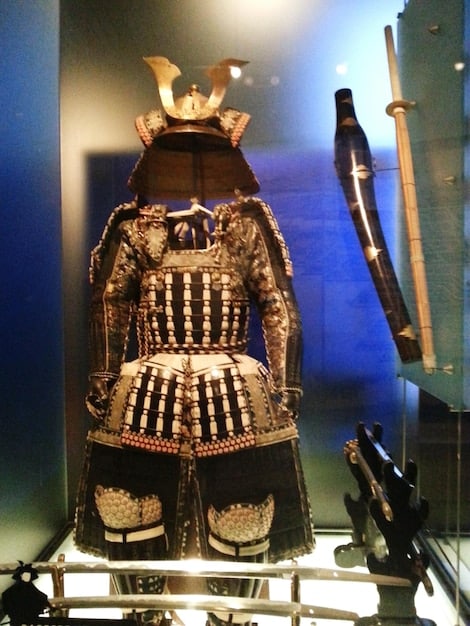
Top Museums to Visit in Tokyo
Tokyo, as Japan’s capital, houses a vast array of museums catering to diverse interests. From classical art to modern design, these institutions provide invaluable insights into Japanese culture.
Navigating Tokyo’s museum scene can be overwhelming, but focusing on key institutions will ensure a rewarding experience. Here are a few must-visit museums:
Tokyo National Museum
Home to an extensive collection of Japanese art and antiquities, the Tokyo National Museum is a must-see for any art enthusiast. Allow ample time to explore its various galleries, showcasing everything from ancient ceramics to samurai armor. They provide English audio guides.
Mori Art Museum
Located on the top floors of the Roppongi Hills Mori Tower, this museum features contemporary art exhibitions with stunning panoramic views of the city. Its innovative displays and thought-provoking themes make it a favorite among modern art lovers. Check out the current exhibitions, as they vary.
Ghibli Museum
For animation aficionados, the Ghibli Museum offers a whimsical journey into the world of Studio Ghibli, the creators of beloved films like “Spirited Away” and “My Neighbor Totoro.” Advance ticket purchase is essential, and be prepared for a magical experience.
Remember to check museum websites for opening hours, admission fees, and special exhibitions. Many museums offer discounts for students or seniors, so be sure to inquire upon arrival.
Tokyo’s museums offer a compelling blend of art, history, and culture, providing a rich introduction to Japan’s artistic landscape. Planning your visits in advance will ensure a smooth and memorable experience.
Exploring Art Beyond Tokyo: Kyoto and Beyond
While Tokyo is a cultural hub, other regions of Japan offer unique artistic experiences that are well worth exploring. Kyoto, in particular, is renowned for its traditional arts and crafts.
Venture beyond Tokyo to uncover hidden artistic gems in other parts of Japan. Here are a few destinations to consider:
Kyoto’s Traditional Arts
Kyoto is home to numerous temples and shrines adorned with exquisite artwork, as well as traditional craft workshops where you can witness artisans practicing their skills. Visit the Kyoto National Museum to delve into the region’s artistic heritage.
Kanazawa’s 21st Century Museum of Contemporary Art
This museum features a striking collection of contemporary art in a visually stunning building. Its interactive exhibits and innovative design make it a popular destination for art lovers of all ages.
Naoshima’s Art Island
Located in the Seto Inland Sea, Naoshima is an island dedicated to art, with outdoor sculptures, art installations, and museums housing works by renowned artists. It provides a unique and immersive art experience amid breathtaking natural scenery.
- Attend Local Festivals: Many festivals include artistic performances or displays.
- Explore Temple Art: Temples often house beautiful paintings and sculptures.
- Visit Craft Villages: See artisans at work preserving traditional techniques.
Exploring art beyond Tokyo offers a diverse range of experiences, from traditional crafts to contemporary installations. Each region boasts its unique artistic identity, providing a deeper understanding of Japan’s cultural richness.
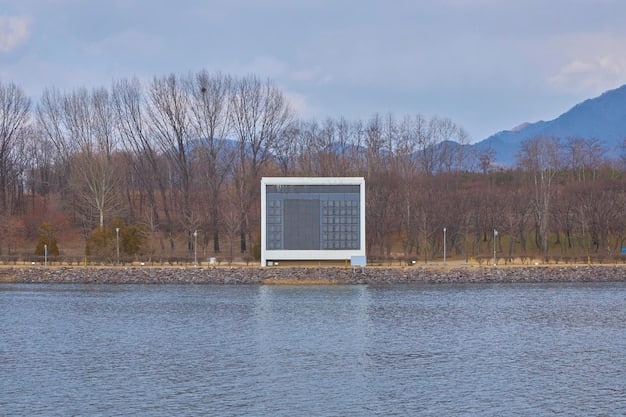
Tips for US Visitors: Navigating Japanese Museums
Visiting museums in Japan can be a unique experience, and a few tips can help US visitors navigate the cultural nuances and logistical considerations.
To ensure a smooth and enjoyable museum visit, keep the following suggestions in mind:
Language Considerations
While many museums offer English signage and audio guides, it’s helpful to learn a few basic Japanese phrases. Being able to say “excuse me” (sumimasen) or “thank you” (arigato) will be appreciated.
Etiquette
In general, avoid talking loudly or using your phone inside the museum. Photography may be restricted in certain areas, so pay attention to signage. Also, be mindful of personal space and avoid touching artwork unless explicitly allowed.
Transportation and Tickets
- Utilize Public Transport: Japan’s public transport is efficient.
- Consider a Japan Rail Pass: If traveling extensively.
- Purchase Tickets in Advance: Especially for popular museums.
Understanding these basic guidelines will help you navigate Japanese museums with greater ease and respect, enhancing your overall cultural experience.
By preparing for these cultural and logistical considerations, US visitors can enjoy a more enriching and authentic museum experience in Japan.
Japanese Gardens as Outdoor Art Spaces
Beyond traditional museums and galleries, Japanese gardens offer a unique perspective on art and culture through nature. Consider these serene spaces as outdoor art installations.
Japanese gardens are meticulously designed landscapes that blend natural elements with artistic principles. These gardens evoke a sense of tranquility and harmony, providing a peaceful retreat from the bustling city.
Types of Japanese Gardens
Each garden style has unique features and philosophy. The main ones are:
- Zen Gardens (Karesansui): Dry landscapes featuring carefully arranged rocks and sand.
- Stroll Gardens (Kaiyū-shiki): Designed for leisurely walks, with ponds, islands, and winding paths.
- Tea Gardens (Roji): Simple, rustic spaces intended to enhance the tea ceremony experience.
Key Elements of Garden Design
Aesthetics focus on minimalist expression, restraint and natural forms.
- Rocks: Represent mountains or islands, adding structure and visual interest.
- Water: Symbolizes purity and tranquility, reflecting the surrounding landscape.
- Plants: Carefully selected to provide seasonal color and texture, creating a harmonious composition.
Visiting these gardens offers a profound appreciation for the interplay between nature and art, providing a unique glimpse into Japanese aesthetics.
Take the time to immerse yourself in the serene beauty of Japanese gardens, appreciating the subtle artistry and philosophical depth that they embody. These spaces offer a refreshing perspective on art and culture, extending beyond the confines of traditional museums and galleries.
Planning Your Art and Culture Itinerary
Crafting a well-planned itinerary is essential for maximizing your art and culture experiences in Japan. Start by identifying your interests and prioritizing the destinations and museums that align with your preferences.
Structuring your trip involves these steps:
Prioritize Interests
Determine your favorite types of art: focus on relevant regional artists and traditional vs. comtemporary trends.
- Duration and Season: Consider how long you’ll stay and when you’re traveling.
- Regional Focus: Plan to visit a specific region or multiple cities.
- Budget: Establish a daily budget.
Booking Accommodations and Transportation
Research and arrange your accommodations and transportation in advance, especially during peak travel seasons. Consider purchasing a Japan Rail Pass if you plan to travel extensively by train.
Embrace Flexibility
Leave room in your itinerary for spontaneous discoveries and unexpected encounters. Some of the most memorable experiences come from venturing off the beaten path and embracing the unknown.
With careful planning and a flexible mindset, you can create an itinerary that perfectly balances structure and spontaneity, ensuring a rewarding and unforgettable art and culture journey through Japan.
| Key Point | Brief Description |
|---|---|
| 🎨 Must-See Museums | Tokyo National Museum, Mori Art Museum, and Ghibli Museum. |
| 🏯 Beyond Tokyo | Explore art in Kyoto, Kanazawa, and Naoshima. |
| 🎎 Museum Tips | Learn basic Japanese, respect etiquette, and book tickets ahead. |
| 🌿 Japanese Gardens | Experience Zen, Stroll, and Tea Gardens as art spaces. |
Frequently Asked Questions
▼
The Tokyo National Museum, Mori Art Museum, and Ghibli Museum are highly recommended. Each provides a unique view into Japanese art and culture. They are great for US visitors.
▼
Yes, it’s highly advisable, especially for popular museums like the Ghibli Museum. Booking ahead ensures you won’t miss out due to sold-out slots. Plan your visit.
▼
Avoid loud conversations, refrain from using your phone, and be mindful of photography restrictions. Also, respecting personal space is seen as good manners.
▼
Absolutely! Kyoto (temples/crafts), Kanazawa (contemporary art) and Naoshima (art island) offer diverse artistic experiences. These sites are accessible and enriching for any tourist.
▼
Yes, these spaces are designed blending art with the natural land. With rocks, water and plants, they represent a minimalist form and a symbol of beauty.
Conclusion
With a well-structured itinerary and a sense of cultural awareness, US visitors can unlock the wonders of Japan’s art and culture scene. From iconic museums in Tokyo to serene gardens and regional artistic treasures, Japan offers a journey that will inspire and enrich your appreciation for global arts.
